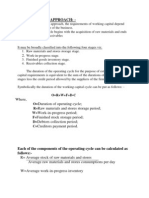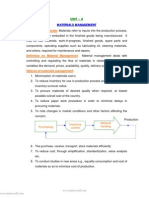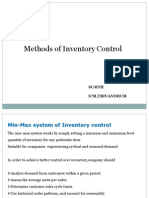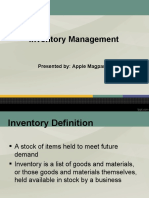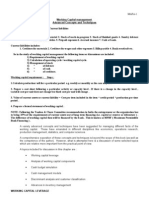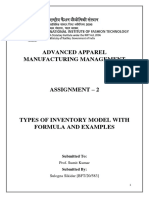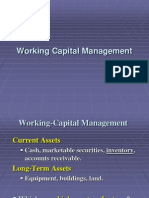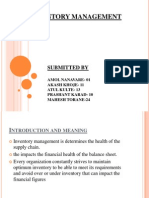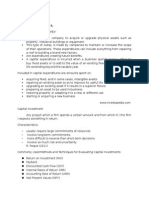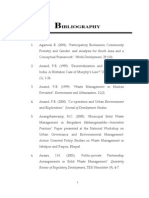Inventory Management Case Study
Inventory Management Case Study
Uploaded by
Qaws QawsCopyright:
Available Formats
Inventory Management Case Study
Inventory Management Case Study
Uploaded by
Qaws QawsOriginal Description:
Copyright
Available Formats
Share this document
Did you find this document useful?
Is this content inappropriate?
Copyright:
Available Formats
Inventory Management Case Study
Inventory Management Case Study
Uploaded by
Qaws QawsCopyright:
Available Formats
Coverdrive Ltd Case Study Working Capital Management Inventory Control Since joining Coverdrive, John Thistle the
e management accountant, has been implementing various systems linked to short-term planning and reporting. He has recently focused on a review of the stock holding of raw materials, consumables and maintenance spares and having conducted a full physical stock take and valuation at quarter ended 31 March he is concerned at the lack of control that exists in ordering issue and control of some stock items. At a recent management meeting John had agreed with Steve Ambrose, the MD, that one of his short-term objectives as management accountant would be a full review of working capital requirements and its control. He reports his concerns expressed regarding the control of stocks and Steve asks him to prepare a presentation on the issues of inventory control for the next management meeting, to which he plans to invite both the production and stores managers. Preliminary notes prepared by John in advance of the meeting In manufacturing and distributive trades, inventories (or stocks) constitute a substantial portion of total assets employed. Inventory control comprises accounting and the physical control of materials, work-in-progress and finished goods. Accounting control is effected by the use of a series of control accounts for each category listed above and stores ledger accounts relating to quantities and values of stock on hand. Physical control comprises strategy for buying, handling, storing, issuing, supervising the stores function and taking stock. Inherent in any system of inventory control is the concept of stock levels, which are normally expressed in physical units but may also be in money terms. The objective of establishing control levels is to ensure that excessive stocks are not carried and working capital is not sacrificed, thereby avoiding the likelihood of being out of stock of any material. What are the factors to be considered when establishing control levels?
WORKING CAPITAL MANAGEMENT MAY 2003
These include: i ii iii iv v vi vii viii Working capital available and the cost of capital. Average consumption or production requirements. The re-order period the period between placing the order and receiving delivery. Storage space available. Market conditions. Economic order quantity. Possibility of loss through deterioration or obsolescence. Costs of ordering, receiving, inspecting and accounting.
The stock levels used in inventory control systems for both accounting and physical measures are minimum stock, maximum stock, re-order level and the re-order quantity or economic order quantity; and I suggest that we implement such controls across our range of stock. Minimum stock level: The lowest level to which stocks should normally be allowed to fall, and is held as a buffer stock to be made available in situations of non-delivery by a supplier. It takes into account the re-order level and average consumption in the average delivery period. Maximum stock level: The highest level to which stock should normally be allowed to rise, otherwise too much working capital is tied up, thus sacrificing liquidity, and there is a risk of loss through deterioration and obsolescence. It takes account of the re-order level, the re-order quantity and the minimum consumption in the minimum delivery period. Re-order level: This is the level at which an order would normally be raised. It takes into account the maximum usage in the maximum delivery period. Re-order quantity or economic order quantity: This is the quantity which is most economical to order as it minimises the costs of ordering and the carrying costs such as storage, insurance and interest on capital. Once the re-order quantity has been determined, the other control levels can be determined by the following formulae: Minimum stock level = Re-order level (average usage in average delivery period).
WORKING CAPITAL MANAGEMENT MAY 2003
Maximum stock level = Re-order level + re-order quantity (minimum usage in minimum delivery period). Re-order level = maximum usage x maximum delivery period. Example: The following relates to stock item COV 5, calculate: re-order level maximum stock level minimum stock level 1200 units maximum 900 units minimum maximum 4 months minimum 2 months 3000 units
Usage per month: Estimated delivery period: Re-order quantity:
Re-order level = 4 x 1200 = 4800 units Maximum level = 4800 + 3000 - (900 x 2) = 6000 units Minimum level = 4400 - (1050 x 3) = 1250 units The tabulation below shows a typical cycle of events for this stock item. This is a monthly summary and assumes that stock was received on the last day of month 2 and 5. Re-order levels would have been reached at the start of month 1, prior to the end of month 3 and towards the latter part of month 6. This summary is based on monthly receipts and issues. However the status of stock would be reported daily. Stock Item COV 5 (Units) Re-order and usage profile: Month 1 Month 2 Month 3 Month 4 Month 5 Month 6 Opening balance Issues Issues Receipt of order Issues Issues Issues Receipt of order Issues Quantity 1200 1100 3000 1200 1200 1100 3000 1100 Balance 5000 3800 2700 5700 4500 3300 2200 5200 4100
WORKING CAPITAL MANAGEMENT MAY 2003
When graphed this profile shows:
6000 5000 4000 UNITS 3000 2000 MINIMUM LEVEL 1000 RE-ORDER LEVEL MAXIMUM LEVEL
3 MONTHS
The graph shows the movement of stock and the levels kept within the predetermined levels of control. In the model illustrated so far, the re-order quantity is given. However, consideration must now be given to the determination of the economic order quantity. When an order is placed with a supplier, certain start-up costs such as administration are incurred. If this was the only factor for consideration, we would make the order as large as possible, thus benefiting from maximum discounts. But, as previously mentioned, we must consider the holding costs. The economic order quantity is that quantity which minimises the total of the starting and carrying costs. There are two methods of determining this. One is the tabular method, the other by mathematical model.
WORKING CAPITAL MANAGEMENT MAY 2003
(i) Where
Mathematical formula Q A P S Q = = = = = Economic order quantity Annual demand in units Cost of placing an order Cost of holding one unit in stock for one year 2AP S
Assume that in case of a further stock item COV 6, 6000 units are required annually and that expenses relating to start up costs are 25 per order and carrying costs are 0.20 per unit per annum. Orders could be arranged in lots of 600, 1200, 2000, 3000 or 6000. Then: Q Q = = 2 x 6000 x 25 0.20 1225 units or 5 orders per annum
Tabular Method (1) (2) (3) (4) (5) Order size Frequency of orders Average stock (1/2 batch size) Starting costs (no. of orders x 25) Carrying costs (average stock x 0.20) 600 10 300 250 60 310 1200 5 600 125 120 245 2000 3 1000 75 200 275 3000 2 1500 50 300 350 6000 1 3000 25 600 625
Total Cost
From this tabulation it appears that the EOQ is 1200 units as this minimises the total costs.
WORKING CAPITAL MANAGEMENT MAY 2003
Presented Graphically 600 500 400 300 200 100 0 1 2 3 Order size 4 5 6 000s units Cost Total cost Economic order quantity 1200 Carrying cost
Conclusion Intend to apply these controls and this model to a sample of stock items over the next few months to determine the possible savings in terms of investment in working capital.
WORKING CAPITAL MANAGEMENT MAY 2003
You might also like
- M-201 Instructor Guide - Facilities ManagementDocument196 pagesM-201 Instructor Guide - Facilities Managementthpvxhfi50% (2)
- IMT 58 Management Accounting M3Document23 pagesIMT 58 Management Accounting M3solvedcareNo ratings yet
- Syllabi Of: B.Tech (Civil) Syllabus - 2010 (Semester 8)Document9 pagesSyllabi Of: B.Tech (Civil) Syllabus - 2010 (Semester 8)sayoojNo ratings yet
- Merger and Demerger of CompaniesDocument11 pagesMerger and Demerger of CompaniesSujan Ganesh100% (1)
- Pre Final Fin 04Document89 pagesPre Final Fin 04patricia gunioNo ratings yet
- FM II Cha-5-1Document10 pagesFM II Cha-5-1yeshiwasdagnewNo ratings yet
- PPC Unit V Problems in Invenrory ManagementDocument26 pagesPPC Unit V Problems in Invenrory ManagementkannanNo ratings yet
- 2019 CIA P3 SIV 1D 2 Working CapitalDocument68 pages2019 CIA P3 SIV 1D 2 Working CapitalMarieJoiaNo ratings yet
- Operating Cycle Approach: - : O R+W+F+D-C O R W F D CDocument4 pagesOperating Cycle Approach: - : O R+W+F+D-C O R W F D CHardik SaliyaNo ratings yet
- MSE - UNIT - 3.pptmDocument26 pagesMSE - UNIT - 3.pptm3111hruthvikNo ratings yet
- Sort ItDocument12 pagesSort Itrickyfox143No ratings yet
- Finman Reviewer - Finals Current Assets: Fixed Assets:: Net Working CapitalDocument15 pagesFinman Reviewer - Finals Current Assets: Fixed Assets:: Net Working CapitalHoney MuliNo ratings yet
- OPM FINAL Assignment PDFDocument17 pagesOPM FINAL Assignment PDFAreef Mahmood IqbalNo ratings yet
- Inventory ManagementDocument6 pagesInventory ManagementMarc Jervin BitongNo ratings yet
- Inventory ManagementDocument8 pagesInventory Managementsouhardya.research.1No ratings yet
- Chapter 5Document51 pagesChapter 5rrrrNo ratings yet
- Working Capital ManagementDocument78 pagesWorking Capital ManagementJoan Marie100% (1)
- Materials Management Materials Management Materials Management Materials ManagementDocument19 pagesMaterials Management Materials Management Materials Management Materials ManagementMuralidhar DasariNo ratings yet
- Inventory Control TechniquesDocument20 pagesInventory Control TechniquesJA SujithNo ratings yet
- Inventory Management: Presented By: Apple MagpantayDocument31 pagesInventory Management: Presented By: Apple MagpantayRuth Ann DimalaluanNo ratings yet
- Working Capital ManagementDocument98 pagesWorking Capital ManagementGanesh PatashalaNo ratings yet
- Chapter 02 (Inventory Management)Document8 pagesChapter 02 (Inventory Management)Keratul Islam Saad-bin SarkerNo ratings yet
- Pma Chapter 2 .Document19 pagesPma Chapter 2 .alisya qistinaNo ratings yet
- InventoryDocument22 pagesInventorynosaduwaNo ratings yet
- Economic Order QuantityDocument10 pagesEconomic Order Quantitypapia rahman100% (1)
- ABC Inventory ControlDocument63 pagesABC Inventory Controlsanjiv_nidamboor100% (2)
- MB0045Document18 pagesMB0045Sameer RukeNo ratings yet
- OPM101Chapter12 000Document51 pagesOPM101Chapter12 000N Satish MohanNo ratings yet
- Inventory Management First Steps in Inventory ManagementDocument5 pagesInventory Management First Steps in Inventory ManagementDeepanjan ChakrabortiNo ratings yet
- Aamm Assmt2 PDFDocument11 pagesAamm Assmt2 PDFSulogna SikidarNo ratings yet
- 00 Inventory ManagementDocument28 pages00 Inventory ManagementTannu SharmaNo ratings yet
- 3 Material Costing - TheoryDocument6 pages3 Material Costing - Theoryspam spamNo ratings yet
- BBA III Internal AssignmentDocument32 pagesBBA III Internal AssignmentMamtaSharmaNo ratings yet
- CH 9 Inventory ManagementDocument6 pagesCH 9 Inventory ManagementSemiraNo ratings yet
- Ch-05 Material Inventory Controls (Online Class)Document6 pagesCh-05 Material Inventory Controls (Online Class)shayan zamanNo ratings yet
- 1-Working CapitalDocument13 pages1-Working CapitalAwaiZ zahidNo ratings yet
- Mod 1 Sub 3 RevisedDocument27 pagesMod 1 Sub 3 Revisedmaheshbendigeri5945No ratings yet
- Inventory ManagementDocument12 pagesInventory ManagementnensimaeNo ratings yet
- Economic Order QuantityDocument7 pagesEconomic Order QuantityShuvro RahmanNo ratings yet
- Inventory Management PDFDocument6 pagesInventory Management PDFa0mittal7No ratings yet
- Financial Management Week 13.1Document49 pagesFinancial Management Week 13.1Rizal BNo ratings yet
- Chapter 5-Inventory ManagementDocument27 pagesChapter 5-Inventory Managementbereket nigussieNo ratings yet
- Inventory ControlDocument7 pagesInventory ControlDarshan RautNo ratings yet
- Inventory Management: Kharylle Conol Stefie Marie Lee Honey Gladys MonteadoraDocument22 pagesInventory Management: Kharylle Conol Stefie Marie Lee Honey Gladys MonteadoraCorazon Lim LeeNo ratings yet
- ABC Analysis: What Is The EOQ Model?Document2 pagesABC Analysis: What Is The EOQ Model?ishu2773737081No ratings yet
- Chapter 6 - Managing Inventory and PayableDocument28 pagesChapter 6 - Managing Inventory and PayableFatimah Rashidi VirtuousNo ratings yet
- Materials ManagementDocument19 pagesMaterials Managementsanjay975No ratings yet
- Üretim 9.1Document63 pagesÜretim 9.1yogesh280785No ratings yet
- Management of Working Capital (2) - InventoryDocument6 pagesManagement of Working Capital (2) - Inventorylightpekka2003No ratings yet
- Assignment of Inventory ManagementDocument3 pagesAssignment of Inventory ManagementHarsh Chauhan50% (2)
- Inventory ManagementDocument18 pagesInventory ManagementAmolnanavareNo ratings yet
- What Is The Economic Order QuantityDocument24 pagesWhat Is The Economic Order QuantitysaketrathiNo ratings yet
- Module 4 NotesDocument13 pagesModule 4 NotesrajiNo ratings yet
- Inventory ManagementDocument8 pagesInventory ManagementYuvraj KawatraNo ratings yet
- Presented By:-Sarita Malviya Bharat Baldua Monika Ghodki Anamika BhargavDocument38 pagesPresented By:-Sarita Malviya Bharat Baldua Monika Ghodki Anamika BhargavBharat Baldua67% (3)
- Inventory Management NotesDocument21 pagesInventory Management Noteskitti123prasad86% (7)
- Term Paper On Inventory Control Techniques: Nikhil Ratnakaran 1PT11MBA35 Section BDocument12 pagesTerm Paper On Inventory Control Techniques: Nikhil Ratnakaran 1PT11MBA35 Section BNikhil RatnakaranNo ratings yet
- Inventory ManagementDocument9 pagesInventory ManagementAngelie Dela CruzNo ratings yet
- Inventory PDFDocument22 pagesInventory PDFKatrina MarzanNo ratings yet
- Unit 3 Inventory ManagementDocument14 pagesUnit 3 Inventory ManagementNayan kakiNo ratings yet
- Management Accounting: Decision-Making by Numbers: Business Strategy & Competitive AdvantageFrom EverandManagement Accounting: Decision-Making by Numbers: Business Strategy & Competitive AdvantageRating: 5 out of 5 stars5/5 (1)
- The Entrepreneur’S Dictionary of Business and Financial TermsFrom EverandThe Entrepreneur’S Dictionary of Business and Financial TermsNo ratings yet
- Southeast University: Midterm ExamDocument24 pagesSoutheast University: Midterm Examramisha tasnuvaNo ratings yet
- Statement of Account: Date Narration Chq./Ref - No. Value DT Withdrawal Amt. Deposit Amt. Closing BalanceDocument2 pagesStatement of Account: Date Narration Chq./Ref - No. Value DT Withdrawal Amt. Deposit Amt. Closing BalancenitzzNo ratings yet
- Urnal Asional: Reni NoviantiDocument13 pagesUrnal Asional: Reni NoviantiMuhammad Nuriadi MentengNo ratings yet
- UntitledDocument2 pagesUntitledsaiee22No ratings yet
- eCOW PTW Audit FormDocument2 pageseCOW PTW Audit Formchung_vmNo ratings yet
- As 1199.0-2003 Sampling Procedures For Inspection by Attributes Introduction To The ISO 2859 Attribute SampliDocument10 pagesAs 1199.0-2003 Sampling Procedures For Inspection by Attributes Introduction To The ISO 2859 Attribute SampliSAI Global - APACNo ratings yet
- F 09420010120134019 PP T 06Document21 pagesF 09420010120134019 PP T 06Morita MichieNo ratings yet
- Position Profile - James J. Hill Center - Executive DirectorDocument5 pagesPosition Profile - James J. Hill Center - Executive DirectorLars LeafbladNo ratings yet
- Lasagna Parlor: Home Made Lasagna With An Unprecedented Taste. Serving You As Per Your Convenience. Give It A TryDocument11 pagesLasagna Parlor: Home Made Lasagna With An Unprecedented Taste. Serving You As Per Your Convenience. Give It A TrySyed BilalNo ratings yet
- (MAC1) Job Order CostingDocument10 pages(MAC1) Job Order CostingBSA 1-2 RUIZ, MARC BRIAN S.No ratings yet
- Capital Expenditure - ReportDocument8 pagesCapital Expenditure - Reportmagoimoi100% (1)
- BSG 2017 - Business Strategy Game - Guide How To Win - V2 BSG 2017 - Business Strategy Game - Guide How To Win - V2Document35 pagesBSG 2017 - Business Strategy Game - Guide How To Win - V2 BSG 2017 - Business Strategy Game - Guide How To Win - V2chichung91No ratings yet
- COWL Annual Report 2018Document151 pagesCOWL Annual Report 2018angelia natashaNo ratings yet
- Solution Exercises Chapter 2 Part 3Document7 pagesSolution Exercises Chapter 2 Part 3Khaja MoinNo ratings yet
- Diesel Vehicles NGT Delhi NCR OrderDocument12 pagesDiesel Vehicles NGT Delhi NCR OrderPankaj KumarNo ratings yet
- 09 Chapter 3Document56 pages09 Chapter 3madhu vinayNo ratings yet
- TarpaulinDocument18 pagesTarpaulinMarie grace UmpayNo ratings yet
- Projected Financial StatementsDocument2 pagesProjected Financial StatementsRobert Dominic GonzalesNo ratings yet
- VIRENDRADocument9 pagesVIRENDRADeepak GoswamiNo ratings yet
- BibliographyDocument45 pagesBibliographyRavikar ShyamNo ratings yet
- Accounting Questions Week 3Document2 pagesAccounting Questions Week 3milleranNo ratings yet
- Alberta International Offices ReviewDocument20 pagesAlberta International Offices ReviewEdmonton SunNo ratings yet
- ARGOS Cape - Adequate - ExplanationDocument3 pagesARGOS Cape - Adequate - Explanationlomaxpl1No ratings yet
- Case Study (Green House)Document3 pagesCase Study (Green House)karishma ghaziNo ratings yet
- Marketpeak Pitchdeck PDFDocument11 pagesMarketpeak Pitchdeck PDFJerome YaraNo ratings yet
- BudgetDocument269 pagesBudgetRavi CharanNo ratings yet
- Berhampur Rice Mills OdishaDocument14 pagesBerhampur Rice Mills OdishaBlazeDream Technologies Pvt LtdNo ratings yet








